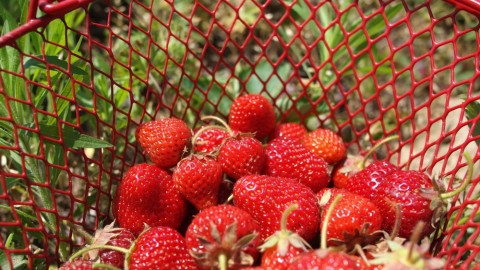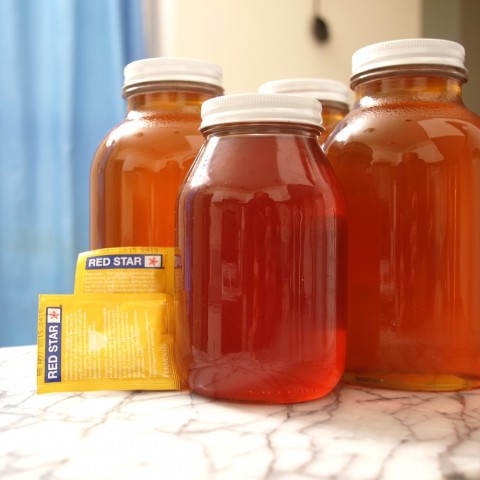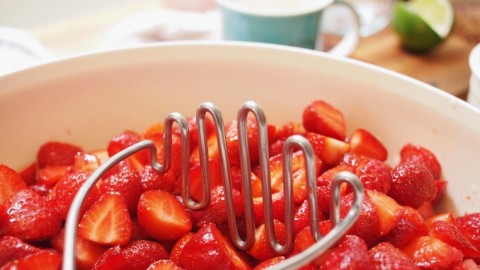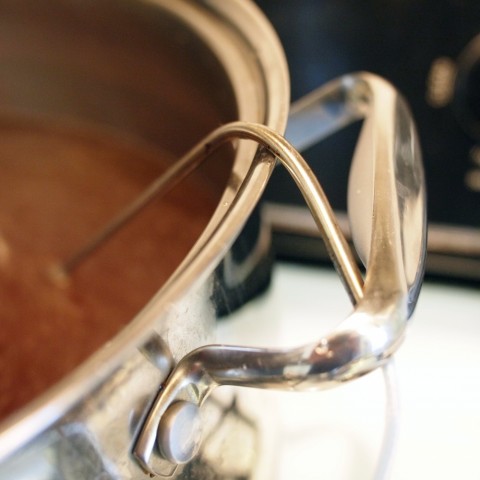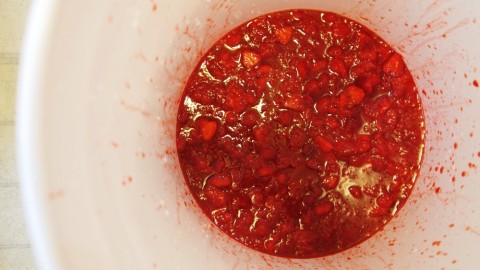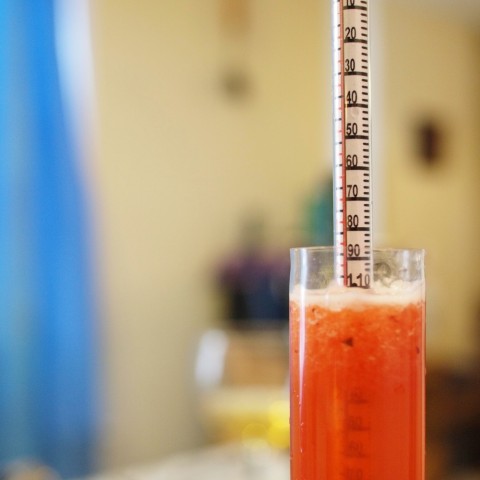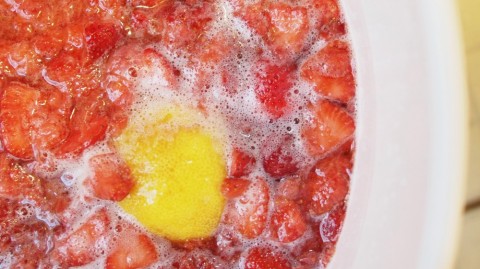It wasn’t my plan to start a new mead this past week. On Monday, I thought to myself that this summer might be a good time to test the waters of melomel, fruit mead, a style that I had never attempted before. But later in the summer would be better, I thought, when blackberries were ready, or even once pears had come into their bloom. Definitely, there should be melomel sometime this season. But definitely, that sometime was not now.
And then there were strawberries — buckets and buckets of the best strawberries in the greater Philadelphia area, ripe almost to bursting, at a price that was far too good to be refused.
I have to admit, I was hesitant. Talking with Linda, who has been my co-conspirator in this particular meady adventure, I hemmed and hawed about the idea of a strawberry mead. Strawberry can be sort of a gaudy fruit, I told her, if that adjective can be so applied. I was worried that it might overwhelm the character of the honey, or come out tasting false, like the esters they use to flavor all of those terrible strawberry candies. And strawberry felt somehow inauthentic to me as a melomel flavoring — un-Viking-like, perhaps — whereas blackberry or pear seemed just about right.
But practical considerations, and the overwhelmingly excellent quality of this particular crop of fruit, overcame all my objections. And so on Wednesday, I gathered my supplies: honey, yeast, and several gallons of the bottled spring water that I don’t particularly like, but that is superior to municipal water in that it contains no chemicals that inhibit microbial growth. And then Thursday began the fun.
Thursday morning saw a trip out to New Jersey to visit McCann’s Farm, the folks who anchor my local farmer’s market, whose produce I love to death, who offer great deals (not to mention a good time) if you’re willing to truck out there to pick your own fruit. Linda gathered just about twelve pounds of strawberries, for some projects that I’ll talk about in part two of this post. I gathered just about ten. And that afternoon, and most of Friday, consisted of a very long exercise in stemming, hulling and slicing our bounty.
Common wisdom — by which I mean the wisdom of the Internet — dictates that a proper strawberry melomel should use seven to ten pounds of fruit. So I guess in that sense, this is a proper strawberry melomel. But in lots of other ways, I’m … innovating.
First, this isn’t going to be a sweet mead. Every melomel I’ve ever sipped, and most every one I’ve read about, go for a sort of dessert aesthetic. Because they’re laden with fruit, I imagine the logic goes, they must taste like fruit compote, or fruit syrup, or one of those Midwestern wild wines that goes so well with a couple of cubes of ice.* Well this one, not so much. As is my custom with meads, I pitched a high-alcohol, fast-fermenting, neutral-tasting yeast (in this case Red Star’s Pasteur Champagne), and I expect that my mead will be left with zero residual sugar. Which is just the way I likes it.
Second, I didn’t boil. I know that there is a lot of conversation out there about the best way to demicrobialize raw honey. And I know that there is a significant faction that prefers low-heat pasteurization or Campden tablets (sodium metabisulfite) to a nice brewer’s boil. But every piece of advice I’ve gotten from fermentation experts says that it’s 210F or bust. And with every previous mead, I’ve followed that course. But again, this time, not so much. This time, in an effort to preserve the subtleties of the delicious butterbean honey that went into the pot, I decided to go with the low-temp crowd and pasteurize at 145F for ten minutes. So I guess we’ll see how that goes.
And finally, there’s the issue of the fruit. The melomel consensus seems to be that fruit is best added to the secondary fermentation, where it can be sanitized by the already-alcoholic mead, and where the violence of that initial yeasty orgy doesn’t destroy its delicate flavors. But I couldn’t make that happen. All of the great timing in the world wouldn’t have allowed me the window to get to secondary between Monday, when I started thinking about mead, and Thursday, when I acquired my strawberries. And besides, I don’t have a glass fermentation vessel that’s anywhere near large enough for a batch of mead plus more than a gallon of fruit, and too much plastic makes me uncomfortable. So I did the best I could with the tools at hand, and tossed the strawberries in the bucket.
But innovations or no, I’m not worried. My initial hydrometer reading puts the sugar level (and therefore the projected alcohol level) right where I want. The honey and fruit and water are all fermenting happily away in my beer fridge. And even if some of the fruit flavor floats out through the airlock, thanks to the fabulous McCann’s, all is not lost. So intense and so ripe were those strawberries that I can’t imagine an end result that won’t be recognizably, deliciously what it is.
At any rate, here’s my ingredient list. I’m not including instructions because making booze is kind of an involved process. But if you’re interested, there’s an excellent primer on how to do it over at Got Mead.
18 lb Butterbean Honey
10 lb Organic Strawberries (which makes about 25 cups, once they’re stemmed and halved)
4 gallons Filtered Water
2 packets Dry Pasteur Champagne Yeast
1 Lemon, organic or well washed
Expert fermenters out there: do let me know what you think!
* You know I love you, Indiana! Even if I don’t especially care for your ‘soft’ wines.
